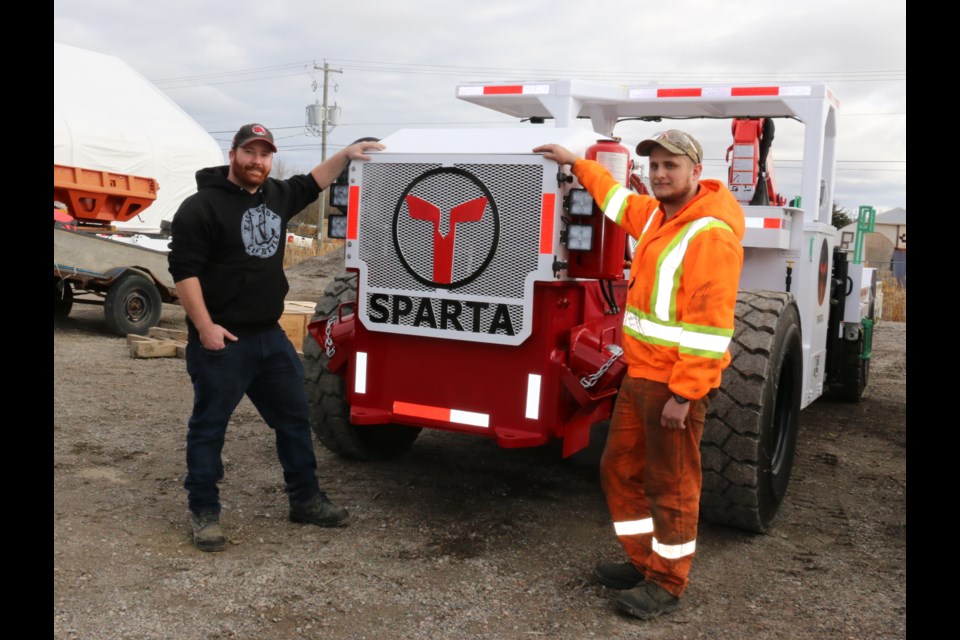A Sudbury-based mining equipment supply company has launched a unique user case study to measure the effectiveness of HydraGEN™ Technology underground by measuring the changes in emissions and fuel economy on mobile diesel equipment in a Northern Ontario mine.
Total Equipment Services Inc. (TES) of Chelmsford has installed a HydraGEN™ unit onto one of the company’s SPARTA Utility Vehicles – a boom truck – that is currently in operation at the mine, which is not being named during the test period.
The HydraGEN™ technology was developed by the firm dynaCERT Inc., a Canadian company that manufactures and distributes Carbon Emission Reduction Technology (CERT) for use with internal combustion engines.
DynaCERT was declared the top winner during the Mining Cleantech Challenge in Denver in March. Their company beat out 11 other companies representing the U.S., Canada and Israel.
The company describes HydraGEN as “patented technology that creates hydrogen and oxygen on demand through a unique electrolysis system and supplies these gases through the air intake to enhance combustion, resulting in lower carbon emissions and greater fuel efficiency.
“Our technology is designed for use with many types and sizes of diesel engines used in on-road vehicles, reefer trailers, off-road construction, power generation, mining and forestry equipment, marine vessels and railroad locomotives,” said the company website.
Tammy Graham, director of business development at TES, said the partnership with the two companies began as a chance meeting at the annual convention of the Prospectors and Developers Association of Canada (PDAC).
“Last year at the PDAC we ran into dynaCERT. They had a booth there and we started talking to them,” said Graham.
She said many mining companies are looking at ways to reduce diesel exhaust emissions on their existing underground mobile equipment for reasons of worker safety, along with environmental initiatives and fuel economy.
She said TES company president Kevin Whynott began discussions with dynaCERT that went on for several weeks.
“Kevin decided this was a company that really figured out the technology in a way that others had not,” Graham explained.
“He wanted to move slowly to make sure he could properly test the product in a mine. So he reached out to one of his customers that has SPARTA units underground and they went in and did a risk assessment on the unit,” she said.
The Workplace Risk Assessment and Control (WRAC) was undertaken to develop a better understanding of any occupational health and safety hazards that could possibly arise from the installation of a HydraGENä Unit, she explained.
Company president Whynott was pleased with the success of risk assessment procedure.
“We are excited by this groundbreaking development to start testing the effectiveness of the HydraGENä units underground. We know how important lowering diesel emissions are to the mining community. As the advancement other emission solutions have been slow moving, we are confidently hoping that this is a solution that can start lowering emission immediately,” he said.
Jim Payne, president-CEO of dynaCERT, was also pleased.
“At dynaCERT, we have always understood the opportunity for our HydraGENä Technology which provides carbon emission reduction and NOx reductions to the underground mining industry. TES has been a strong supporter and catalyst in obtaining approval of what is a key milestone for our Company. I thank Kevin Whynott and his entire team for their important achievement.”
“So now the HydraGEN™ unit is going underground. It is going to be tested in an environment without the unit running. Then they’re going to turn the unit on and test it in the same environment. Then we will develop a case study from that and see what the results are.
“The units are robust. They can be installed, not only on our SPARTA units, but on any mobile units,” said Graham. She said the point is to prove the equipment can withstand the rugged underground mining environment and also to show that the lower emissions and fuel economy will match the results that dynaCERT has achieved in operating mobile equipment on surface.
Graham said she was optimistic about the testing procedures for the HydraGEN™ units.
“Yes, it is a good partnership. We are exclusive dealers for the mining industry so this will definitely be a benefit for TES as well," she said.




